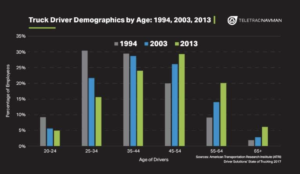Why the DRIVE Safe Act is Important
Official Name: Developing Responsible Individuals for a Vibrant Economy Act
For those of us who follow Trucking news, March 21st, 2018 came with big hopes in gaining some momentum for both the steady recovery of the current driver shortage and legally allowing young drivers to perform over the road jobs which take them over state lines.
Representatives Duncan Hunter (CA-50) and Trey Hollingsworth (IN–9), with support from the International Foodservice Distributors Association (IFDS) and the American Trucking Associations (ATA), introduced the DRIVE-Safe Act, critical legislation which is tackling the commercial driver shortage by rigorously training and empowering young drivers. This bill would direct the Secretary of Transportation to issue regulations to permit an 18-21year old CDL holder to drive a Commercial Motor Vehicle across state lines, during and upon the completion of a two-step apprenticeship program.
Step One
The first step is a 120 Hour on duty Probationary Period out of which 80 hours must be driving time. During the 80 hours of driving time, the apprentice may drive interstate, but only when accompanied in the passenger seat by an experienced truck driver. During this time the apprentice must demonstrate the following core competencies: interstate, light city traffic, rural two lanes, evening driving; safety awareness; speed and space management; lane control, mirror scanning, right and left turns; compliance with logging Hours of Service. Also the apprentice may not operate a Commercial Motor Vehicle with Hazardous materials placards.
Step Two
The second step is a 280 Hour on duty Probationary Period out of which 160 hours must be driving time. During the 160 hours of driving time, the apprentice may drive interstate, but only when accompanied in the passenger seat by an experienced truck driver. During this time the apprentice will be judged on backing and maneuvering in close quarters; pre-trip inspections; fueling procedures; weighing loads; weight distribution; sliding tandems; coupling and uncoupling procedures; trip planning, truck routes; map reading; navigation, permits; transporting hazardous materials is allowed under correct circumstance.
Let’s also tackle some points on why the need for this legislation, so we can understand why it is so important.
First off, Truck Driver Shortage
We previously discussed the acute Driver Shortage, which has yet to show signs of improvement. We looked at the US being short 50,000 truck drivers at the end of 2017. That’s a huge number considering consumer needs grow yearly and more and more goods will hit the road. The legislation, by allowing drivers between 18 and 21 years of age to drive interstate will attempt to minimize this gap allowing high school graduates to consider trucking as a career. Whereas before, the 3-year gap between graduating high school and being allowed to cross state lines as a commercial driver severely lowered interest.
Second, Foodservice Distribution Industry
The foodservice distribution industry has been impacted by the shortage of truck drivers. Hundreds of thousands of products in need to be delivered daily are burdening the current fleet. The industry has a combined sales annual sales volume of almost $300 billion. IFDA member companies operate more than 800 facilities in US and internationally. With DRIVE Safe Act there will be a continuous supply of well-trained truck drivers.
Third, Aging Truck Driving Fleet
We’ve tacked this topic before to describe some of the factors attributing to drivers’ shortage. The average age of today’s truck driver is 49 years old and due to some of the physical duties some have to perform such as aiding with loading and unloading, some are retiring early. Organizations are using modern technology and social media to attract younger generations. The DRIVE Safe Act will only give organizations yet another tool to help fill their empty seats.
In Summary
The DRIVE Safe Act affects the young drivers between ages 18 and 21. By going through the rigorous requirements of the 2 step program they will be able to operate commercial vehicles across state lines. This will ensure more well trained truck drivers are filling today’s shortage while the needs of the foodservice distribution industry are met. The DRIVE Safe Act gets a thumbs up from us.






Post a comment